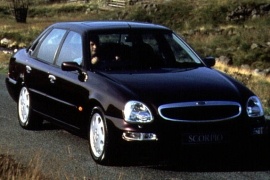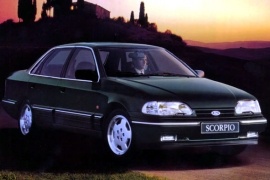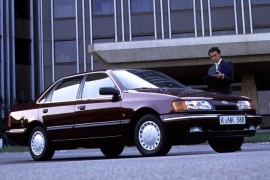FORD Scorpio Sedan Models/Series Timeline, Specifications & Photos
First production year: 1990
Engines: Gasoline, Diesel
Ford tried to keep up with the European executive car market and made a final attempt with the Scorpio lineup in 1994, but the low sales made the blue-oval badge drop the lineup.
The Scorpio was the last rear-wheel-drive car sold by Ford in Europe, and the carmaker tried to put it against competitors such as Opel/Vauxhall Omega. There was no way to compete against the 5-Series from BMW or E-Class from Mercedes-Benz. While it was priced lower than those, it couldn't keep up with the German premium brands' technological improvements. As a result, just three years after the 1994 facelift, Ford stopped the Scorpio lineup.
The Scorpio was just too bulky. It was hard to say if its headlights were triangular or rounded. Moreover, there was a massive metallic part for the trunk lid in the back and just a thin red light-strip that crossed the car from side to side. Overall, the media considered the new design upgrade as more of a downgrade.
Inside, the Scorpio featured an upgraded interior with a dashboard centered around the driver. Its center stack featured the climate control units above the radio-cassette player. Ford placed the elegant, round, analog clock in a position where the driver couldn't see it most of the time due to the steering wheel. It was a roomy vehicle, with plenty of room for four passengers, but the old platform with a tall transmission tunnel made it unusable for a third person unless it was a toddler in a child seat.
Things got even worse under the hood. Its outdated engines provided less power than smaller engines supplied by its competitors, while the top-of-the-range version was very thirsty on the gas.
Just two years after the first facelift, Ford introduced another refresh for its European flagship range, the Scorpio.
This time, the blue-oval brand had all the knowledge to do things right. They learned that the Peugeot engines were too slow and opted to use only the WM Motori turbocharged units, which were at least acceptable, but still slower than what BMW and Mercedes-Benz offered for their cars. Ford's attention turned toward the design, and it improved.
Bigger, rounded headlights, bigger grille, and smoother lines were the main attributes of the 1992 Scorpio facelift. The bumpers got redesigned, and in the back, the car received bigger taillights. It was finally looking like a mid-size executive sedan.
The interior was far better, with smoother lines on the dashboard. It even featured a center stack with the HVAC controls placed on the top and the audio controls underneath them. It improved the sound-deadening materials, and the fittings inside finally matched those installed on the BMW 5-Series. The Ghia trim-level featured power seats, leather upholstery, and wood-trims on the dash and door panels.
Under the hood, Ford dropped the carbureted engines and improved the efficiency for the others. But the car was still unconvincing from the performance point of view. The base version provided 120 hp, but it was from the 1990 model-year. The Cosworth, 2.9-liter engine was powerful enough to propel the vehicle well beyond 120 mph (194 kph), but it was still thirsty.
Ford introduced the Scorpio as its flagship model for the European market in 1985, but it only made it a hatchback. A mistake which was corrected in 1989 when it launched the first facelift.
Ford seemed to forget that most of the executive cars were sedans and offered the Scorpio as a hatchback only. Soon, it realized the mistake and went back to the drawing board to give the car two more shapes: a sedan and a station wagon. Apart from the bodywork changes, the carmaker tried to improve other parts of the vehicle.
In late 1989, Ford unveiled the facelifted Scorpio sedan. It featured a restyled front fascia with slightly curved headlights and a very small grille above the front bumper since it was a facelift for the range. The designers installed a bigger one on the apron, which helped to cool the engine. Since it was a three-box sedan, the cabin featured a shorter roofline and a sloped rear window. The third row of windows was placed between the C- and the D-pillars, increasing the interior light, especially for the rear seat passengers.
Inside, the Scorpio featured a roomy interior with enough legroom and headroom for all the passengers. Despite having a transmission tunnel, the rear floor was flat enough to offer three real seats on the bench. Unfortunately, Ford didn't invest too much in the interior improvements, and the instrument cluster and the dashboard remained similar to the 1985 model.
One of the problems with the Scorpio was its engine range, which lacked power. After 1989, it received more powerful versions. Unfortunately, those were very thirsty. With a Peugeot unit under the hood, a diesel version was a better option, but it was slow.


